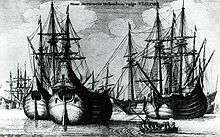Fluyt
.jpg)
A fluyt (archaic Dutch: fluijt "flute"; Dutch pronunciation: [flœy̯t] (![]()
Ship design
The standard fluyt design minimized or completely eliminated its armaments to maximize available cargo space, and used block and tackle extensively to facilitate ship operations. Another advantage of its pear-shape (when viewed from the fore or aft) was a shallow draft which allowed the vessel to bring cargo in and out of ports and down rivers that other vessels could not reach. This ship class was credited in enhancing Dutch competitiveness in international trade, and was widely employed by the Dutch East India Company in the 17th and 18th centuries.[4] However, its usefulness caused the fluyt to gain such popularity that similar designs were soon developed by seagoing competitors of the Dutch. For example, the English shipbuilding industry began to adapt the design of the fluyt during the later part of the 17th century as English merchants, seeing how much cheaper the Dutch shipping was, acquired Dutch-built ships that were captured in the Anglo-Dutch wars.[6]
The design of fluyts was largely similar to that of the early galleons. These ships typically weighed 200-300 tons and were approximately 80 feet (24 metres) in length. The pear-shaped vessel had a large cargo bay near the waterline and a relatively narrow deck above. In part, this design served to avoid high taxes collected by Denmark in the Øresund, assessed based on the area of the main deck. The fluyt was square rigged with two or three masts. Masts were much higher than those of galleons to allow for greater speed. At times fluyts were also armed and served as auxiliary vessels, which was a common practice in the Baltic Sea.
Replicas
The Hector, constructed in Pictou, Nova Scotia and launched in 2000, is a replica of an early 18th-century fluyt which, in the summer of 1773 carried 189 Scottish immigrants to Nova Scotia. The replica was constructed according to line drawings from the Maritime Museum Rotterdam, and built using traditional shipbuilding techniques. As of 2017, the Hector is operated by the Hector Quay Society and is open to the public.[7]
Images
 Dutch fluyts of the 17th century
Dutch fluyts of the 17th century Model of the late 17th century fluyt Derfflinger - front view
Model of the late 17th century fluyt Derfflinger - front view Stern view
Stern view%2C_Pictou%2C_Nova_Scotia.jpg) The Hector, A replica of an 18th-century fluyt
The Hector, A replica of an 18th-century fluyt
See also
References
- ↑ van Brederode, Willem; Doedens, A. (2008). Doedens, A.; Looijesteijn, Henk, eds. Op jacht naar Spaans zilver: het scheepsjournaal van Willem van Brederode, kapitein der mariniers in de Nassause vloot (1623–1626) [On the hunt for Spanish silver: The logbook of Willem van Brederode, Captain of the Marines in the Nassau Fleet (1623–1626)]. Hilversum: Verloren. ISBN 9789087040475.
- ↑ Wheatley, Joe. "Fluyts and Katts". The Captain Cook Society. Retrieved 11 May 2017.
- ↑ de Vries, Jan (1976). The Economy of Europe in an Age of Crisis, 1600–1750. Cambridge University Press. pp. 117–18.
- 1 2 3 Boxer, CR (1965). The Dutch Seaborne Empire 1600–1800. Alfred A. Knopf.
- ↑ Blanning, Tim (2007). The Pursuit of Glory: Europe, 1648–1815. Penguin. p. 96.
- ↑ Davis, Ralph (1962). The Rise of the English Shipping Industry in the 17th and 18th Centuries. Newton Abbot: David & Charles. pp. 47–54. ISBN 0-7153-5462-0.
- ↑ "Hector Heritage Quay – The Symbol of Scottish Immigration in North America". shiphector.com. Retrieved 2017-07-05.